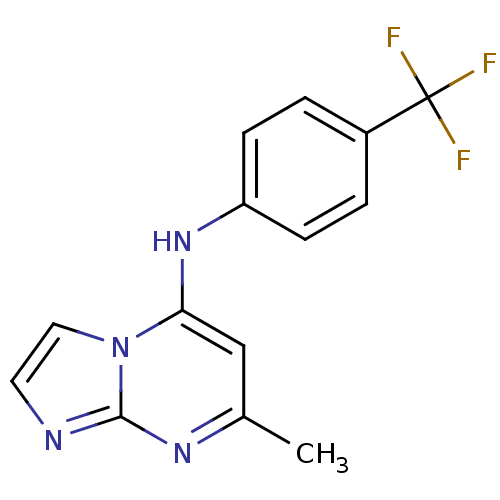

 Search and Browse
Search and Browse
 Download
Download
 Enter Data
Enter Data
| Target/Host (Institution) | Ligand | Target/Host Links | Ligand Links | Trg + Lig Links | Ki nM | ΔG° kJ/mole | IC50 nM | Kd nM | EC50/IC50 nM | koff s-1 | kon M-1s-1 | pH | Temp °C |
|---|---|---|---|---|---|---|---|---|---|---|---|---|---|
| Dihydroorotate dehydrogenase (quinone), mitochondrial (Plasmodium falciparum (isolate 3D7)) | BDBM50396723 (CHEMBL2172226 | US9238653, Table 5, Compound 2) | PDB MMDB KEGG UniProtKB/SwissProt B.MOAD DrugBank GoogleScholar AffyNet | CHEMBL PC cid PC sid UniChem Similars | US Patent | n/a | n/a | 77 | n/a | n/a | n/a | n/a | 8.0 | n/a |
BOARD OF REGENTS, THE UNIVERSITY OF TEXAS SYSTEM; MMV MEDICINES FOR MALARIA VENTURE; UNIVERSITY OF WASHINGTON US Patent | Assay Description For studying inhibition of Plasmodium or human DHODH enzyme, two assays that are in routine use are described, for example, in Baldwin, et al. (2002)... | US Patent US9238653 (2016) BindingDB Entry DOI: 10.7270/Q2D79954 | |||||||||||
| More data for this Ligand-Target Pair | |||||||||||||
| Dihydroorotate dehydrogenase (quinone), mitochondrial (Homo sapiens (Human)) | BDBM50396723 (CHEMBL2172226 | US9238653, Table 5, Compound 2) | PDB MMDB Reactome pathway KEGG UniProtKB/SwissProt B.MOAD DrugBank antibodypedia GoogleScholar AffyNet | CHEMBL PC cid PC sid UniChem Similars | Article PubMed | n/a | n/a | >1.00E+5 | n/a | n/a | n/a | n/a | n/a | n/a |
University of Washington Curated by ChEMBL | Assay Description Inhibition of human DHODH expressed in Escherichia coli BL21(DE3) using 2,6-dichoroindophenol substrate by spectrophotometric analysis | J Med Chem 55: 7425-36 (2012) Article DOI: 10.1021/jm300351w BindingDB Entry DOI: 10.7270/Q24T6KGQ | |||||||||||
| More data for this Ligand-Target Pair | |||||||||||||